Unisa Showcases Breathtaking Sustainable Art, Fusing Creativity and Sustainability
The project was strongly led by the Sustainability Office, housed in the Department of Quality Assurance and Enhancement. The Sustainability Office is always on top of their game in terms of engaging the Unisa community with sustainability matters, and ensuring that the institution engages with the Sustainable Development Goals and the rollout of the Sustainability Framework.
The main objective of this project is to let artists use, reduce, reuse and recycle material to create various types of public artworks that will transform an area. Art on Unisa’s campuses not only adds aesthetic value to the campus environment, but also reflects the institution’s support of local artists and their practices. This becomes even more significant when the core values informing the works are repurposing, recycling and sustainability, and when the artists themselves are selected predominantly from Unisa staff and alumni.
The unveiling programme was led by Dr Bongani Mkhonza from the Department of Art and Music in the College of Human Sciences. In his opening address, Thomson Mhlongo, Director of the Unisa Science Campus, made sure that participants felt genuinely welcome at this event. Prof Thomas Pooley, Chair of the Department of Art and Music, said that the Art Walk shows how the arts and sciences co-exist both in space and in conceptual imagery. Pooley highlighted the value of creative outputs as research.
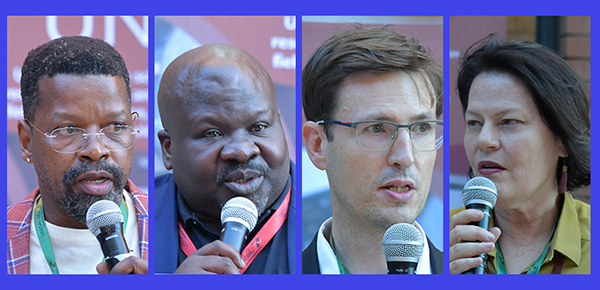
From left: Dr Bongani Mkhonza, Thomson Mhlongo, Prof Thomas Pooley, and Dr Gwenneth Miller
The work of artists, musicians, dancers and actors is now being recognised as akin to that of scientists and researchers in other fields, and creative research outputs are included in applications for National Research Foundation funding. To create a framework for the evaluation of creative research outputs and to ensure their parity of esteem, the Department of Higher Education and Training implemented a Policy on the Evaluation of Creative Outputs and Innovations Produced by Higher Education Institutions in 2017, and published Implementation Guidelines in 2021.
Dr Gwenneth Miller, Senior Lecturer in Unisa’s Department of Art and Music, outlined the process and curation of the Unisa Art Walk from 2019 to 2024. She pointed out that the launch marks the first public unveiling, and that the second reveal will happen when all the works have been completed and installed. Not all the installations have been completed, and some will be executed next year.
Six evolving structures were unveiled at the Science Campus:
- Marian Hester and Mbangiso Mabaso created the physical and augmented reality (AR) work Summer Solstice and Winter Solstice (2023) (Media: mild steel, urethane coated steel, solar lights, augmented reality filters)
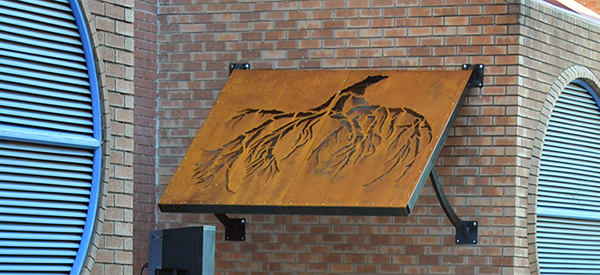
Winter Solstice
Each work is a large steel shade awning which uses the solar angle at noon on the summer or winter solstices to cast shadows on the Art Walk site, and which explores concepts and ideas relating to several different environmental science disciplines, including solar energy engineering, planetary heating and cooling, the growth cycles of plants, recent discoveries in biology and ecological damage.
Summer Solstice casts a shadow on the ground suggesting the phenomenon of “canopy shyness”: the tendency of trees of the same height in a forest to leave space for neighbouring trees. The cast shadow image of the tree canopy will be at its most crisp at noon on 21 December (the summer solstice in the southern hemisphere).
Winter Solstice casts shadows of stylised subterranean tree roots against the wall, the shadows being most crisp on 21 June (the winter solstice).
- Ingrid Bolton created the recycled mural, Sever (2023) (Media: copper cable, aluminium tubes and sheets)
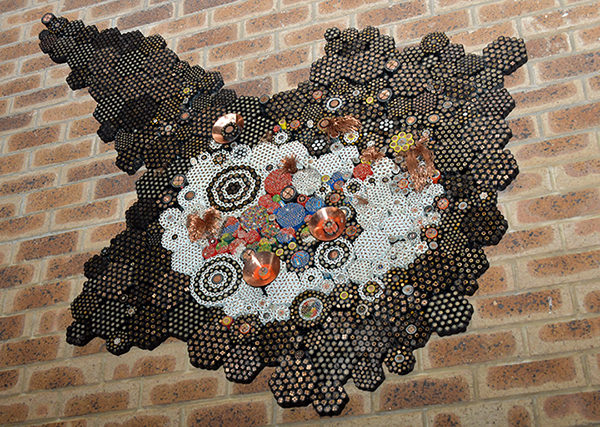
Sever
Bolted onto a wall in proximity to an electrical light, the artwork deals with the severing of our connectivity, by any means. Networks are severed, communication is halted and power is interrupted. Slicing through the cable represents this severing. Cutting is a violent act, as is the removal of copper from cities. Communication, transport via rail and power supply are all affected by the lifting of copper, loadshedding and the misallocation of funds. The separation reveals the inner assembly of the cable and the individual strands of copper and rubber. This reflects the micro or individual connecting strand, within the macro structure or landscape of power outages.
- Reinhard Sonntag created Emergent Systems (2023) (Media: aluminium bars, recycled steel objects, galvanised nuts and bolts, recycled nuts and bolts, metal paper clips, galvanised binding wire, pop rivets)
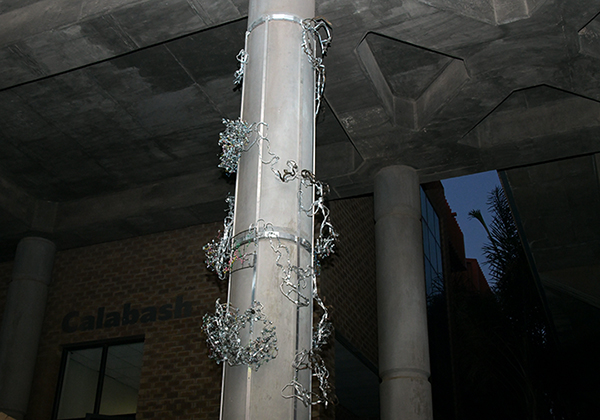
Emergent Systems
The artist examined the interaction of systems in the building, as a reflection of an institution, to propose a space of confrontation of ideas. The work is a sculptural construction consisting of approximately 15 cluster pieces installed on three concrete pillars. It represents a mix of emergent complex systems that “invade” or “infect” the building. The sculptural pieces are built from a variety of metal objects acquired in hardware and stationery stores and collected in scrapyards. The configuration of their components is intended to accentuate the multiplicity, connectedness, and nonlinearity that characterise complex and chaotic systems. The sculptures represent various cellular structures, modes of protein folding and viral processes. They are interspersed with graph-like fragments of pseudo-scientific data visualisation.
- Alicia Vermaak created Point of View (Portrait of Jakes Gerwel) (2023) (Media: plexiglas, steel table, led lights)
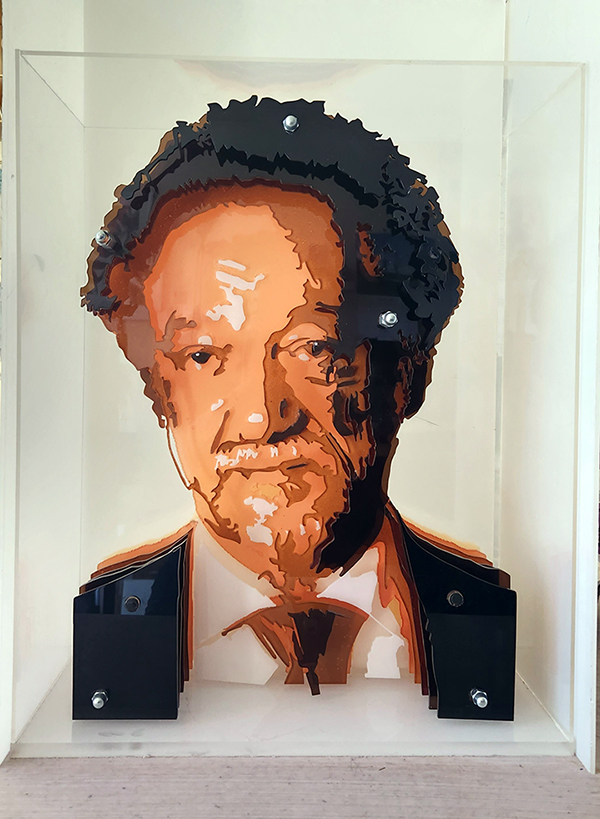
Point of View (Portrait of Jakes Gerwel)
Point of View is a multi-layered sculpture that serves as a tribute to Prof GJ Gerwel, known as Jakes Gerwel. The sculpture honours his remarkable achievements and unwavering determination to succeed in education, especially amidst the discriminatory policies of apartheid. The sculpture employs a precise viewing angle to generate a portrait, creating the perceptual illusion of a cohesive entity. The layers are arranged in a sequential manner, resulting in the perception of the portrait being contingent upon the observer’s perspective. Point of View aims to positively impact Unisa’s students and the community by encouraging viewers to reflect on a remarkable South African educational leader and pioneer in transformation, and by highlighting the valuable contributions that educators make in higher education and the community.
- Linda Hanekom, with Gideon and Life Dlamini, created Kaleidoscope Alchemy (2023) (Media: recycled windshield glass, PERSPEX®, aluminium, steel, M1, stainless steel, bolts, nuts, OSB board and vermiculite concrete)
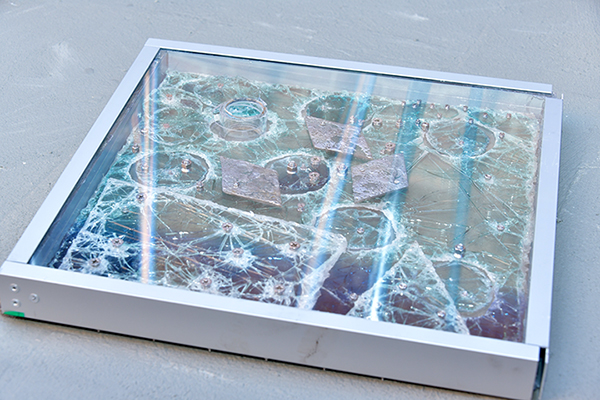
Kaleidoscope Alchemy
Inspired by the entrance to the Science Campus library in the GJ Gerwel building, this work is about development, and about gaining insight and vision. Like a book that is taking flight into another dimension, the recycled windshield glass panels form the focus, infusing new life into the old, discarded material.
The changing dynamics of the 26 panels guides the viewer’s eyes in multiple directions. Several of the facets contain metals such as steel and lead, which are rich in symbolising the alchemy processes of heat and melting, but even more, the desire to change mundane ‘stuff’ and ordinary work rituals into the gold of dreams. Like the Gerwel library, which will soon be filled with books, data of the sciences and cultural heritage, this artwork speaks of hidden knowledges to be uncovered. It’s complex construction of triangles with vertical “pins” which seem to move through the glass, is layered with abstract patterns of grids upon grids. Detailed planning, calculation and contemplation are hinged together and connected like a forest of research. The composition intends to bring light into the space – a space that was previously only heavy concrete and a path to and from work.
The patterns of light that filter through the glass facets onto the concrete suggest a kaleidoscopic place of wonder and imagination. One of the artists’ aims is to inspire the viewer to consider the metamorphosis of weighty burdens into renewed perspectives: to develop perceptions of not only “what” but “how” we choose to exist to illuminate the way forward.
- Lead artist Sue Clark and team: Kabelo Maya, Daniel Maseko, Jens Juterbock, Richard Clark, created Mthimkulu we mpilo (2023) (Media: cleared exotic gum tree trunks, recycled steel)
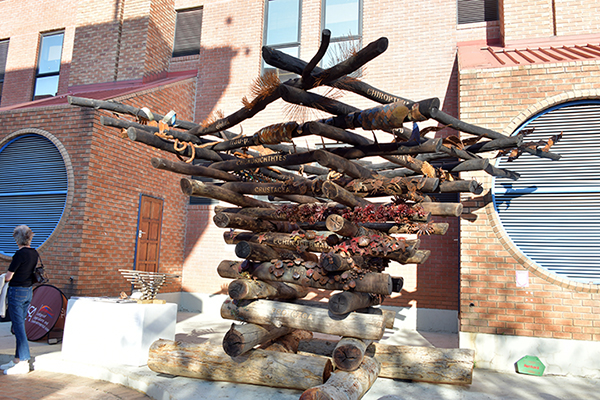
Mthimkulu we mpilo
Mthimkulu we mpilo is the conceptual depiction of a phylogenetic tree of life. This structure speaks of the evolution of organisms and life and their continuing dependence on one another, rather than slavishly reproducing a scientifically accurate example of a phylogenetic diagram. It is a loose visual representation of the evolutionary relationships between species.
In a traditional tree-and-branch structure the branches separate out and do not meet up again (bifurcating tree). In reality, most organism kingdoms are reticulate (net-like) and integrated, and they exist together. Bacteria exist in the guts of animals to digest food. The mycelia of fungi connect plant life and are even said to aid plants in communicating. The structure of this tree is such that it builds up and out like a traditional tree, but in the stacked construction the many kingdoms and species become layers supporting each other with the most “evolved” species being the most vulnerable: remove a trunk and the whole structure becomes unstable. Complex co-existences are required for a sustainable planet. Constructed from cleared exotic tree trunks and recycled steel elements, the once invasive species now take on a new life, as they form the new structure. Recycled steel elements, fixed and embedded into the logs suggest the textures of various living organisms. The sculpture pays homage to the interconnectedness of all life, inviting viewers to ponder the wonders of biodiversity and evolution.

